Wastewater Treatment Costs: A Research Overview through Bibliometric Analysis
Abstract
1. Introduction
2. Materials and Methods
2.1. Bibliometric Analysis
2.2. Data Selection and Processing
- The period analysed was 1950–2020. The analysis yielded a final sample of 22,788 results on wastewater treatment costs. The sample selection was conducted in January 2021.
- The following variables were analysed: evolution, areas of study, main countries, main journals, and main institutions.
- An additional analysis section was introduced to examine differences in scientific research on treatments for water intended for reuse, ultraviolet (UV) and chlorination, as these treatments are the most commonly used options for water disinfection, for various economic and environmental reasons.
- SCImago Journal Rank (SJR): measure of the scientific influence of scholarly journals that accounts for both the number of citations received by a journal and the importance or prestige of the journals where the citations where made [62].
- Quartile in which the journal is positioned.
- Number of citations.
- Journal Impact Factor (JIF): measure of the frequency with which the average article in a journal has been cited in a particular year.
- Total publications.
3. Results
3.1. Evolution of the Research on Wastewater Treatment Costs
3.2. Main Areas of Study in Wastewater Treatment Costs Research
3.3. Relevant Countries in Wastewater Treatment Costs Research
3.4. Journals in Wastewater Treatment Cost Research
3.5. Leader Institutions in Wastewater Treatment Cost Research
3.6. Differences in Scientific Research on Treatments for Wastewater Intended for Reuse: UV and Chlorination
4. Discussion and Conclusions
4.1. Summary of Findings
- For UV, China (22.90%), India, the USA, Spain, Iran, Brazil, Italy, Canada, Germany and Egypt.
- For chlorination, the USA (22.14%), China, Brazil, India, Australia, Canada, France, Italy, Spain and the United Kingdom.
4.2. Implications and Limitations
4.3. Future Research Opportunities
Author Contributions
Funding
Institutional Review Board Statement
Informed Consent Statement
Data Availability Statement
Conflicts of Interest
References
- Vázquez, V.L.; Rodríguez, G.; Daddi, T.; De Giacomo, M.R.; Polders, C.; Dils, E. Policy challenges in transferring the integrated pollution Prevention and control approach to Southern Mediterranean countries: A case study. J. Clean. Prod. 2015, 107, 486–497. [Google Scholar] [CrossRef]
- Martin-Carrasco, F.; Garrote, L.; Iglesias, A.; Mediero, L. Diagnosing Causes of Water Scarcity in Complex Water Resources Systems and Identifying Risk Management Actions. Water Resour. Manag. 2012, 27, 1693–1705. [Google Scholar] [CrossRef]
- Beamonte, E.; Casino, A.; Veres, E.J. Medición de la calidad del agua mediante indicadores. Relación entre éstos y las tarifas de abastecimiento. Estud. Econ. Apl. 2010, 28, 357–374. [Google Scholar]
- Burak, S.; Margat, J. Water Management in the Mediterranean Region: Concepts and Policies. Water Resour. Manag. 2016, 30, 5779–5797. [Google Scholar] [CrossRef]
- Katz, D. Water use and economic growth: Reconsidering the Environmental Kuznets Curve relationship. J. Clean. Prod. 2015, 88, 205–213. [Google Scholar] [CrossRef]
- Su, M.-H.; Huang, C.-H.; Li, W.-Y.; Tso, C.-T.; Lur, H.-S. Water footprint analysis of bioethanol energy crops in Taiwan. J. Clean. Prod. 2015, 88, 132–138. [Google Scholar] [CrossRef]
- Xu, Y.; Huang, K.; Yu, Y.; Wang, X. Changes in water footprint of crop production in Beijing from 1978 to 2012: A logarithmic mean Divisia index decomposition analysis. J. Clean. Prod. 2015, 87, 180–187. [Google Scholar] [CrossRef]
- Uche, J.; Martínez-Gracia, A.; Círez, F.; Carmona, U. Environmental impact of water supply and water use in a Mediterranean water stressed region. J. Clean. Prod. 2015, 88, 196–204. [Google Scholar] [CrossRef]
- Vörösmarty, C.J.; Green, P.; Salisbury, J.; Lammers, R.B. Global water resources: Vulnerability from climate change and pop-ulation growth. Science 2000, 289, 284–288. [Google Scholar] [CrossRef]
- Gleick, P.H. The World’s Water; Island Press: Washington, DC, USA, 2011. [Google Scholar]
- Böhmelt, T.; Bernauer, T.; Buhaug, H.; Gleditsch, N.P.; Tribaldos, T.; Wischnath, G. Demand, supply, and restraint: Determi-nants of domestic water conflict and cooperation. Global Environ. Chang. 2014, 29, 337–348. [Google Scholar] [CrossRef]
- Gizelis, T.-I.; Wooden, A.E. Water resources, institutions, & intrastate conflict. Polit. Geogr. 2010, 29, 444–453. [Google Scholar] [CrossRef]
- De Graaf, I.; van Beek, L.; Wada, Y.; Bierkens, M. Dynamic attribution of global water demand to surface water and groundwater resources: Effects of abstractions and return flows on river discharges. Adv. Water Resour. 2014, 64, 21–33. [Google Scholar] [CrossRef]
- Morote, Á.-F.; Hernández, M. Urban sprawl and its effects on water demand: A case study of Alicante, Spain. Land Use Policy 2016, 50, 352–362. [Google Scholar] [CrossRef]
- Valero, L.G.; Pajares, E.M.; Sánchez, I.M.R.; Pérez, J.A.S. Analysis of Environmental Taxes to Finance Wastewater Treatment in Spain: An Opportunity for Regeneration? Water 2018, 10, 226. [Google Scholar] [CrossRef]
- Organization for Economic Co-Operation and Development (OECD). Water Pricing: Current Practices and Recent Trends; Or-ganization for Economic Co-Operation and Development: Paris, France, 1999. [Google Scholar]
- Garrido-Cardenas, J.A.; Esteban-García, B.; Agüera, A.; Sánchez-Pérez, J.A.; Manzano-Agugliaro, F. Wastewater Treatment by Advanced Oxidation Process and Their Worldwide Research Trends. Int. J. Environ. Res. Public Health 2019, 17, 170. [Google Scholar] [CrossRef]
- Fytianos, G.; Tziolas, E.; Papastergiadis, E.; Samaras, P. Least Cost Analysis for Biocorrosion Mitigation Strategies in Concrete Sewers. Sustainability 2020, 12, 4578. [Google Scholar] [CrossRef]
- Caballero, J.A.; Labarta, J.A.; Quirante, N.; Carrero-Parreño, A.; Grossmann, I.E. Environmental and Economic Water Man-agement in Shale Gas Extraction. Sustainability 2020, 12, 1686. [Google Scholar] [CrossRef]
- Dang, H.T.; Dinh, C.V.; Nguyen, K.M.; Tran, N.T.; Pham, T.T.; Narbaitz, R.M. Loofah Sponges as Bio-Carriers in a Pilot-Scale Integrated Fixed-Film Activated Sludge System for Municipal Wastewater Treatment. Sustainability 2020, 12, 4758. [Google Scholar] [CrossRef]
- Pajares, E.M.; Valero, L.G.; Sánchez, I.M.R. Cost of Urban Wastewater Treatment and Ecotaxes: Evidence from Municipalities in Southern Europe. Water 2019, 11, 423. [Google Scholar] [CrossRef]
- Juszczyk, S.; Balłina, R.; Juszczyk, J. Environment protection costs in polish dairy cooperatives. Ann. Pol. Assoc. Agric. Agribus. Econ. 2020, XXII, 49–59. [Google Scholar] [CrossRef]
- Perez, J.A.S.; Sanchez, I.M.R.; Carra, I. Promoting environmental technology using sanitary tax: The case of agro-food industrial wastewater in Spain. Environ. Eng. Manag. J. 2014, 13, 961–969. [Google Scholar] [CrossRef]
- Ling, J.; Germain, E.; Murphy, R.; Saroj, D. Designing a Sustainability Assessment Tool for Selecting Sustainable Wastewater Treatment Technologies in Corporate Asset Decisions. Sustainability 2021, 13, 3831. [Google Scholar] [CrossRef]
- Arden, S.; Morelli, B.; Schoen, M.; Cashman, S.; Jahne, M.; Ma, X.; Garland, J. Human Health, Economic and Environmental Assessment of Onsite Non-Potable Water Reuse Systems for a Large, Mixed-Use Urban Building. Sustainability 2020, 12, 5459. [Google Scholar] [CrossRef] [PubMed]
- Hardisty, P.E.; Sivapalan, M.; Humphries, R. Determining a sustainable and economically optimal wastewater treatment and discharge strategy. J. Environ. Manag. 2013, 114, 285–292. [Google Scholar] [CrossRef]
- Bonoli, A.; Pennellini, S.; Eshtawi, T.; Qrenawi, L.; Solaroli, M.; Al-Zaanin, N.; Abu Saada, G.; Barilli, E. Appropriate solutions for wastewater reuse in agriculture: A pilot plant in Rafah, Gaza strip. Environ. Eng. Manag. J. 2020, 19, 1683–1692. [Google Scholar] [CrossRef]
- Perulli, G.D.; Gaggia, F.; Sorrenti, G.; Donati, I.; Boini, A.; Bresilla, K.; Manfrini, L.; Baffoni, L.; Di Gioia, D.; Grappadelli, L.C.; et al. Treated wastewater as irrigation source: A microbiological and chemical evaluation in apple and nectarine trees. Agric. Water Manag. 2021, 244, 106403. [Google Scholar] [CrossRef]
- Molinos-Senante, M.; Sancho, F.H.; Garrido, R.S. Estado actual y evolución del saneamiento y la depuración de aguas residuales en el contexto nacional e internacional. Anales Geografía Universidad Complutense 2012, 32, 69–89. [Google Scholar] [CrossRef]
- Melgarejo, J. Efectos Ambientales y Económicos de la Reutilización del Agua en España; Universidad de Alicante: Alicante, Spain, 2009. [Google Scholar]
- Chen, Z.; Ngo, H.H.; Guo, W. A critical review on sustainability assessment of recycled water schemes. Sci. Total. Environ. 2012, 426, 13–31. [Google Scholar] [CrossRef]
- Goodwin, D.; Raffin, M.; Jeffrey, P.; Smith, H.M. Applying the water safety plan to water reuse: Towards a conceptual risk management framework. Environ. Sci. Water Res. Technol. 2015, 1, 709–722. [Google Scholar] [CrossRef]
- Ruiz-Rosa, I.; García-Rodríguez, F.J.; Mendoza-Jiménez, J. Development and application of a cost management model for wastewater treatment and reuse processes. J. Clean. Prod. 2016, 113, 299–310. [Google Scholar] [CrossRef]
- Gharbia, S.S.; Aish, A.; Abushbak, T.; Qishawi, G.; Shawa, I.A.-; Gharbia, A.S.; Zelenakova, M.; Gill, L.; Pilla, F. Evaluation of wastewater post-treatment options for reuse purposes in the agricultural sector under rural development conditions. J. Water Process. Eng. 2016, 9, 111–122. [Google Scholar] [CrossRef]
- Fito, J.; Van Hulle, S.W.H. Wastewater reclamation and reuse potentials in agriculture: Towards environmental sustainability. Environ. Dev. Sustain. 2021, 23, 2949–2972. [Google Scholar] [CrossRef]
- Leonel, L.P.; Tonetti, A.L. Wastewater reuse for crop irrigation: Crop yield, soil and human health implications based on giardiasis epidemiology. Sci. Total. Environ. 2021, 775, 145833. [Google Scholar] [CrossRef]
- Ait-Mouheb, N.; Mayaux, P.L.; Mateo-Sagasta, J.; Hartani, T.; Molle, B. Water reuse: A resource for Mediterranean agriculture. In Water Resources in the Mediterranean Region; Elsevier: Amsterdam, The Netherlands, 2020; pp. 107–136. [Google Scholar]
- Hochstrat, R.; Wintgens, T.; Kazner, C.; Jeffrey, P.; Jefferson, B.; Melin, T. Managed aquifer recharge with reclaimed water: Approaches to a European guidance framework. Water Sci. Technol. 2010, 62, 1265–1273. [Google Scholar] [CrossRef]
- Garcia, X.; Pargament, D. Reusing wastewater to cope with water scarcity: Economic, social and environmental considerations for decision-making. Resour. Conserv. Recycl. 2015, 101, 154–166. [Google Scholar] [CrossRef]
- Wilcox, J.; Nasiri, F.; Bell, S.; Rahaman, S. Urban water reuse: A triple bottom line assessment framework and review. Sustain. Cities Soc. 2016, 27, 448–456. [Google Scholar] [CrossRef]
- Gallego-Valero, L.; Moral-Pajares, E.; Román-Sánchez, I.M. Crop production and irrigation: Deciding factors of wastewater reuse in Spain? Desalin. Water Treat. 2019, 150, 91–98. [Google Scholar] [CrossRef]
- San Juan, J.L.; Caligan, C.J.; Garcia, M.M.; Mitra, J.; Mayol, A.P.; Sy, C.; Culaba, A. Multi-objective optimization of an inte-grated algal and sludge-based bioenergy park and wastewater treatment system. Sustainability 2020, 12, 7793. [Google Scholar] [CrossRef]
- Castellet, L.; Molinos-Senante, M. Efficiency assessment of wastewater treatment plants: A data envelopment analysis ap-proach integrating technical, economic, and environmental issues. J. Environ. Manag. 2016, 167, 160–166. [Google Scholar] [CrossRef]
- Berbeka, K.; Czajkowski, M.; Markowska, A. Municipal wastewater treatment in Poland—Efficiency, costs and returns to scale. Water Sci. Technol. 2012, 66, 394–401. [Google Scholar] [CrossRef][Green Version]
- Djukic, M.; Jovanoski, I.; Ivanovic, O.M.; Lazic, M.; Bodroza, D. Cost-benefit analysis of an infrastructure project and a cost-reflective tariff: A case study for investment in wastewater treatment plant in Serbia. Renew. Sustain. Energy Rev. 2016, 59, 1419–1425. [Google Scholar] [CrossRef]
- Moran, D.; Dann, S. The economic value of water use: Implications for implementing the Water Framework Directive in Scotland. J. Environ. Manag. 2008, 87, 484–496. [Google Scholar] [CrossRef]
- Fu, X.; Niu, Z.; Yeh, M.-K. Research trends in sustainable operation: A bibliographic coupling clustering analysis from 1988 to 2016. Clust. Comput. 2016, 19, 2211–2223. [Google Scholar] [CrossRef]
- Pérez, A.T.E.; Camargo, M.; Rincón, P.C.N.; Marchant, M.A. Key challenges and requirements for sustainable and industri-alized biorefinery supply chain design and management: A bibliographic analysis. Renew. Sustain. Energy Rev. 2017, 69, 350–359. [Google Scholar] [CrossRef]
- Bryman, A.; Bell, E. Business Research Methods; Oxford University Press: Evans Road Cary, NC, USA, 2015. [Google Scholar]
- Archambault, É.; Campbell, D.; Gingras, Y.; Larivière, V. Comparing bibliometric statistics obtained from the Web of Science and Scopus. J. Am. Soc. Inf. Sci. Technol. 2009, 60, 1320–1326. [Google Scholar] [CrossRef]
- Prieto-Sandoval, V.; Jaca, C.; Ormazabal, M. Towards a consensus on the circular economy. J. Clean. Prod. 2018, 179, 605–615. [Google Scholar] [CrossRef]
- Huang, L.; Zhang, Y.; Guo, Y.; Zhu, D.; Porter, A.L. Four dimensional Science and Technology planning: A new approach based on bibliometrics and technology roadmapping. Technol. Forecast. Soc. Chang. 2014, 81, 39–48. [Google Scholar] [CrossRef]
- Aznar-Sánchez, J.A.; García-Gómez, J.J.; Velasco-Muñoz, J.F.; Carretero-Gómez, A. Mining Waste and Its Sustainable Management: Advances in Worldwide Research. Minerals 2018, 8, 284. [Google Scholar] [CrossRef]
- Albort-Morant, G.; Henseler, J.; Leal-Millán, A.; Cepeda-Carrión, G. Mapping the field: A bibliometric analysis of green in-novation. Sustainability 2017, 9, 1011. [Google Scholar] [CrossRef]
- Durieux, V.; Gevenois, P.A. Bibliometric Indicators: Quality Measurements of Scientific Publication. Radiology 2010, 255, 342–351. [Google Scholar] [CrossRef]
- Pauly, D.; Stergiou, K. Equivalence of results from two citation analyses: Thomson ISI’s Citation Index and Google’s Scholar service. Ethics Sci. Environ. Polit. 2005, 9, 33–35. [Google Scholar] [CrossRef]
- Prigle, J. Trends in the use of ISI citation databases for evaluation. Learn. Publ. 2008, 21, 85–91. [Google Scholar] [CrossRef]
- Montoya, F.G.; Baños, R.; Meroño, J.E.; Manzano-Agugliaro, F. The research of water use in Spain. J. Clean. Prod. 2016, 112, 4719–4732. [Google Scholar] [CrossRef]
- López-Serrano, M.J.; Velasco-Muñoz, J.F.; Aznar-Sánchez, J.A.; Román-Sánchez, I.M. Sustainable Use of Wastewater in Ag-riculture: A Bibliometric Analysis of Worldwide Research. Sustainability 2020, 12, 8948. [Google Scholar] [CrossRef]
- Ramos, J.M.; González-Alcaide, G.; Gutiérrez, F. Bibliometric analysis of the Spanish scientific production in Infectious Diseases and Microbiology. Enferm. Infecc. Microbiol. Clin. 2016, 34, 166–176. [Google Scholar] [CrossRef]
- Romo-Fernandez, L.M.; Guerrero-Bote, V.P.; Moya-Anegon, F. Analysis of the Spanish scientific production in Renewable Energy, Sustainability and the Environment (Scopus, 2003–2009) in the global context. Investig. Bibliotecol. 2013, 27, 125–151. [Google Scholar]
- Trinh, L.T.; Duong, C.C.; Van Der Steen, P.; Lens, P.N. Exploring the potential for wastewater reuse in agriculture as a climate change adaptation measure for Can Tho City, Vietnam. Agric. Water Manag. 2013, 128, 43–54. [Google Scholar] [CrossRef]
- Gómez-López, M.; Bayo, J.; García-Cascales, M.; Angosto, J. Decision support in disinfection technologies for treated wastewater reuse. J. Clean. Prod. 2009, 17, 1504–1511. [Google Scholar] [CrossRef]

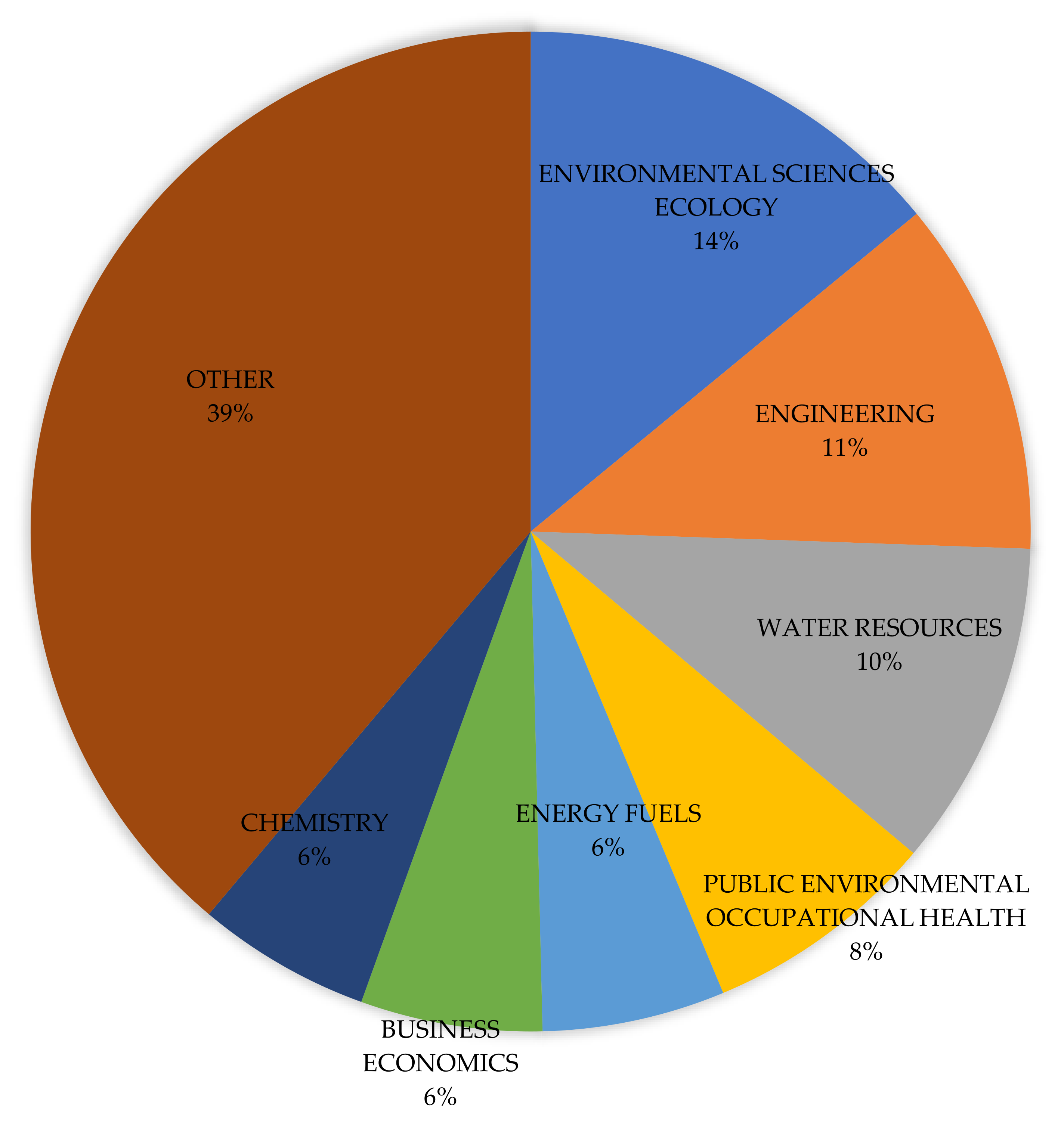

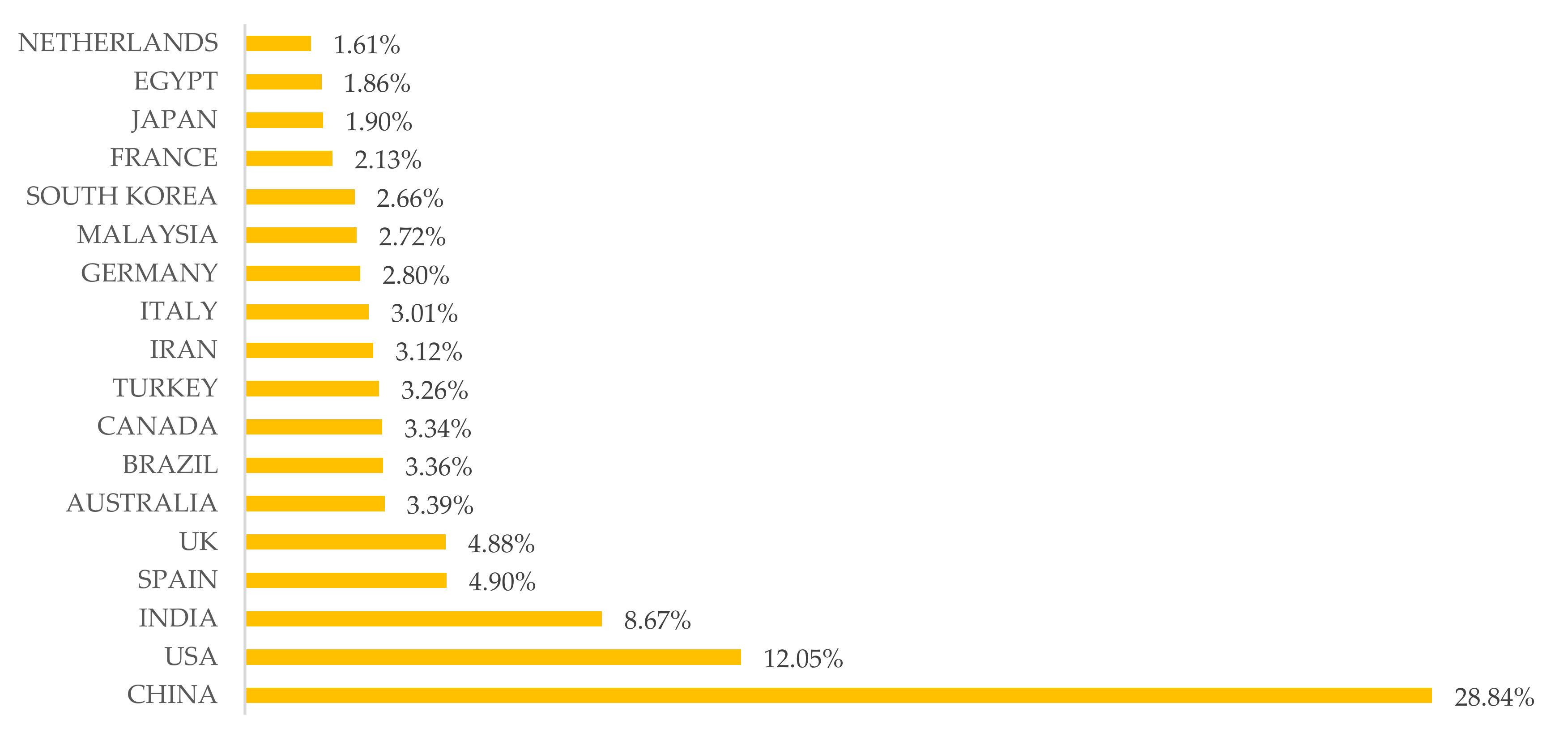
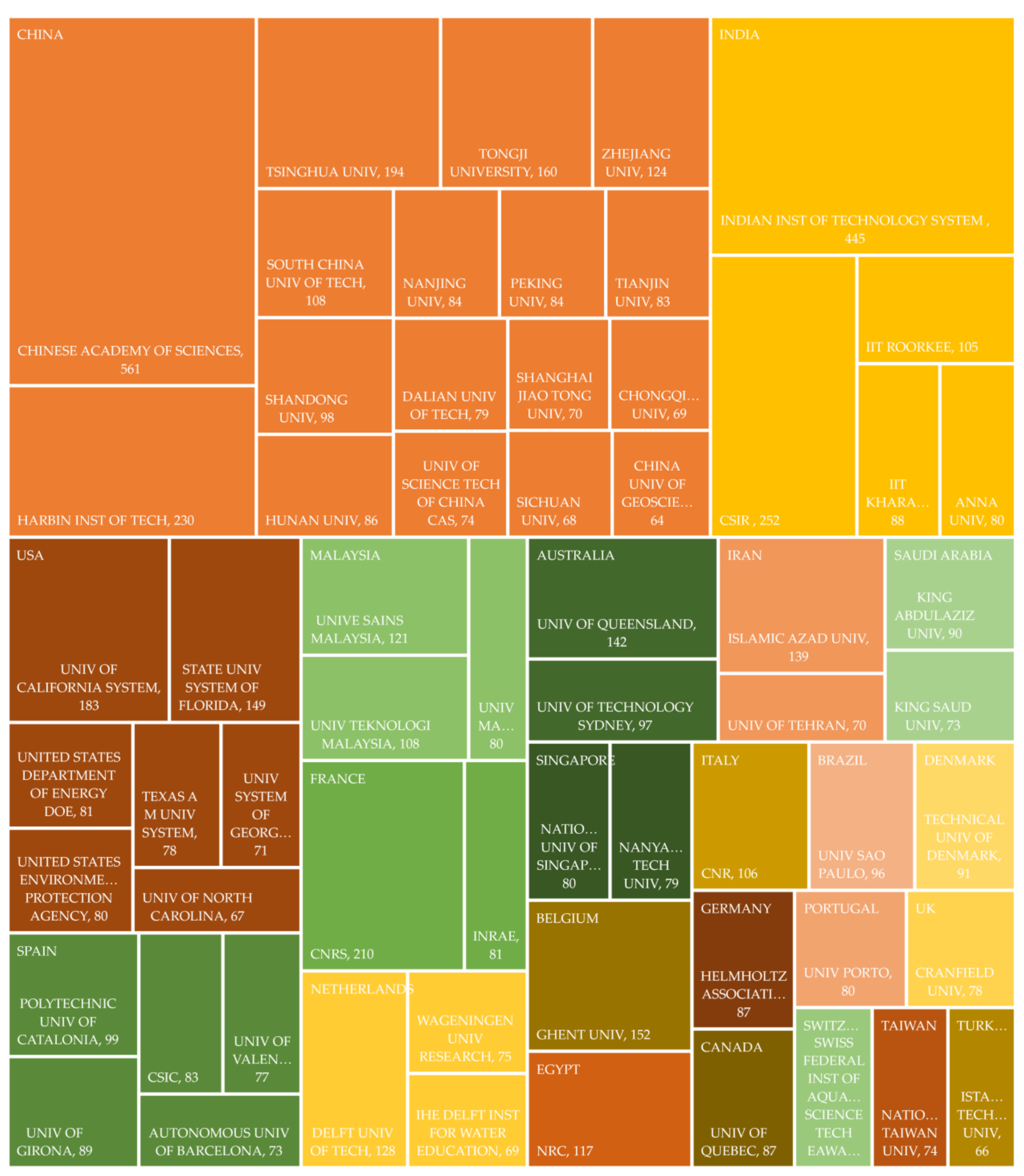
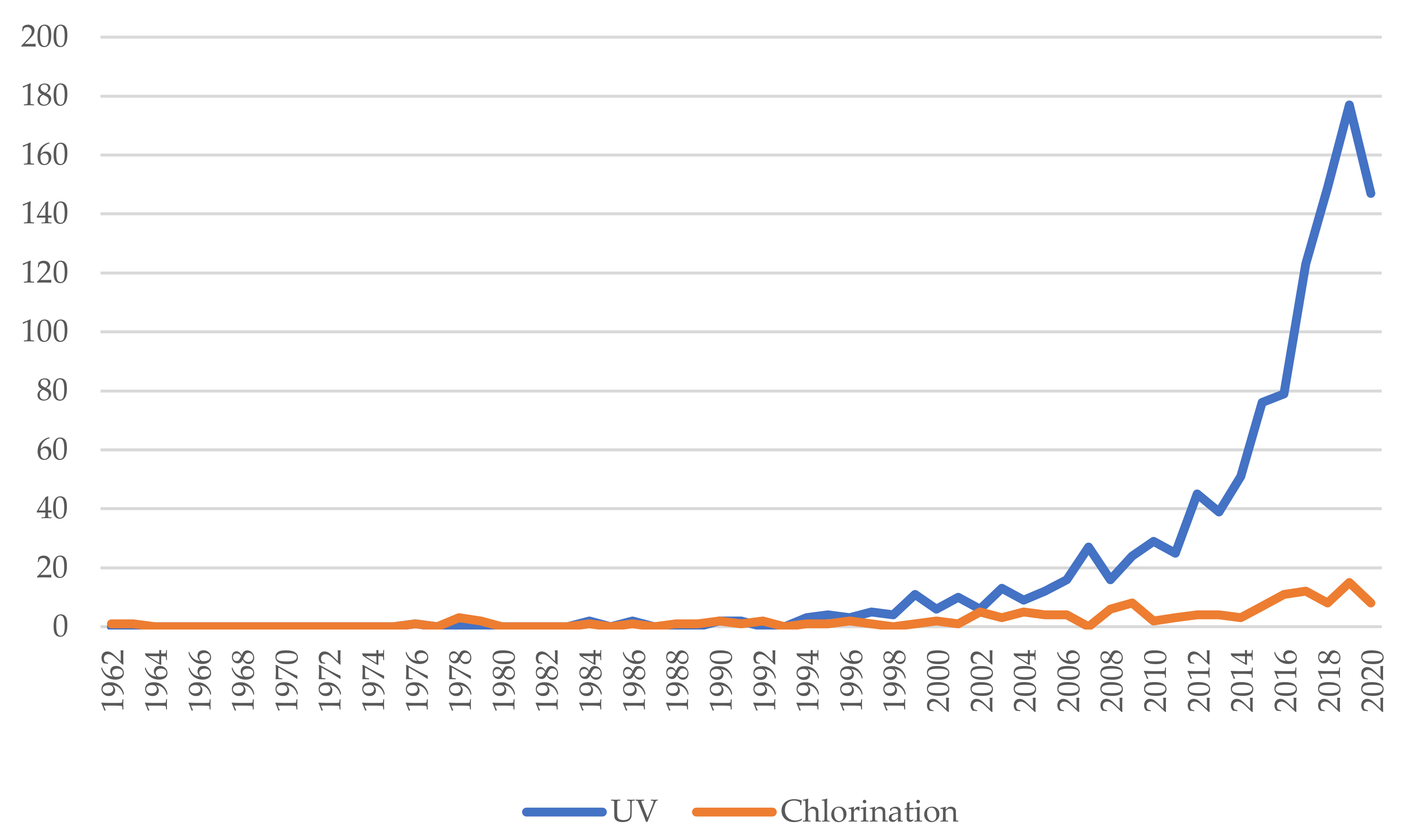
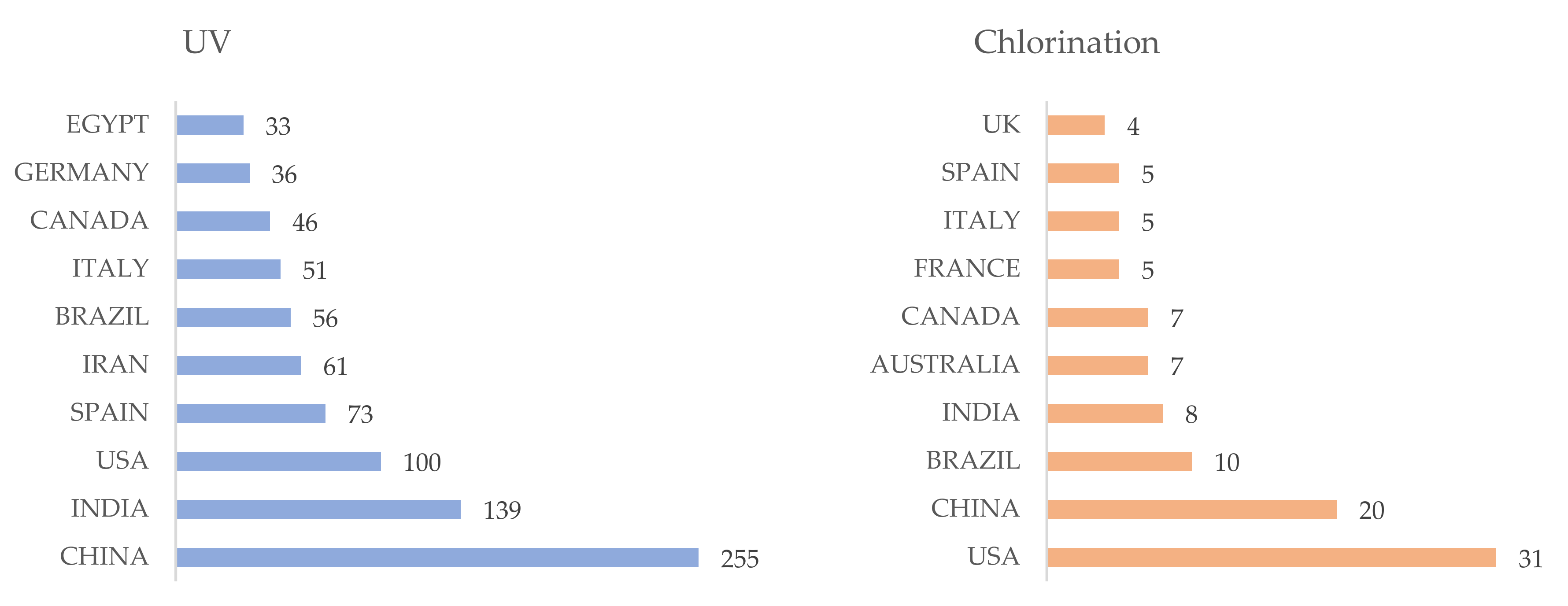
| Journal | Articles | SJR (2019) | Country | JIF (2019) | Total Citations (2019) |
|---|---|---|---|---|---|
| Water Science and Technology | 1471 | 0.47 (Q2) | United Kingdom | 1.638 | 20,937 |
| Chemical Engineering Journal | 709 | 2.32 (Q1) | Switzerland | 10.652 | 129,806 |
| Desalination and Water Treatment | 651 | 0.33 (Q2) | Italy | 0.854 | 14,535 |
| Journal of Hazardous Materials | 552 | 2.01 (Q1) | Netherlands | 9.038 | 110,068 |
| Water Research | 523 | 2.93 (Q1) | United Kingdom | 9.130 | 99,442 |
| Journal of Cleaner Production | 492 | 1.89 (Q1) | Netherlands | 7.246 | 104,138 |
| Bioresource Technology | 468 | 2.43 (Q1) | Netherlands | 7.539 | 131,781 |
| Journal of Environmental Management | 452 | 1.32 (Q1) | USA | 5.647 | 44,264 |
| Environmental Science and Pollution Research | 415 | 0.79 (Q2) | Germany | 3.056 | 46,033 |
| Desalination | 320 | 1.81 (Q1) | Netherlands | 7.098 | 44,845 |
| Environmental Technology | 296 | 0.49 (Q2) | United Kingdom | 2.213 | 7947 |
| Journal of Environmental Chemical Engineering | 281 | 0.93 (Q1) | United Kingdom | 4.300 | 13,023 |
| Science of the Total Environment | 254 | 1.66 (Q1) | Netherlands | 6.551 | 134,962 |
| Chemosphere | 240 | 1.53 (Q1) | United Kingdom | 5.778 | 94,799 |
| Environmental Science & Technology | 221 | 2.7 (Q1) | USA | 7.864 | 187,995 |
| Journal of Chemical Technology and Biotechnology | 202 | 0.66 (Q1) | United Kingdom | 2.750 | 12,232 |
| Water | 176 | 0.66 (Q1) | Switzerland | 2.544 | 13,460 |
| International Journal of Environmental Science and Technology | 174 | 0.52 (Q2) | USA | 2.540 | 6522 |
| Water Environment Research | 173 | 0.3 (Q3) | USA | 1.369 | 3120 |
| Water, Air and Soil Pollution | 169 | 0.54 (Q2) | Switzerland | 1.900 | 15,219 |
Publisher’s Note: MDPI stays neutral with regard to jurisdictional claims in published maps and institutional affiliations. |
© 2021 by the authors. Licensee MDPI, Basel, Switzerland. This article is an open access article distributed under the terms and conditions of the Creative Commons Attribution (CC BY) license (https://creativecommons.org/licenses/by/4.0/).
Share and Cite
Gallego-Valero, L.; Moral-Parajes, E.; Román-Sánchez, I.M. Wastewater Treatment Costs: A Research Overview through Bibliometric Analysis. Sustainability 2021, 13, 5066. https://doi.org/10.3390/su13095066
Gallego-Valero L, Moral-Parajes E, Román-Sánchez IM. Wastewater Treatment Costs: A Research Overview through Bibliometric Analysis. Sustainability. 2021; 13(9):5066. https://doi.org/10.3390/su13095066
Chicago/Turabian StyleGallego-Valero, Leticia, Encarnación Moral-Parajes, and Isabel María Román-Sánchez. 2021. "Wastewater Treatment Costs: A Research Overview through Bibliometric Analysis" Sustainability 13, no. 9: 5066. https://doi.org/10.3390/su13095066
APA StyleGallego-Valero, L., Moral-Parajes, E., & Román-Sánchez, I. M. (2021). Wastewater Treatment Costs: A Research Overview through Bibliometric Analysis. Sustainability, 13(9), 5066. https://doi.org/10.3390/su13095066








